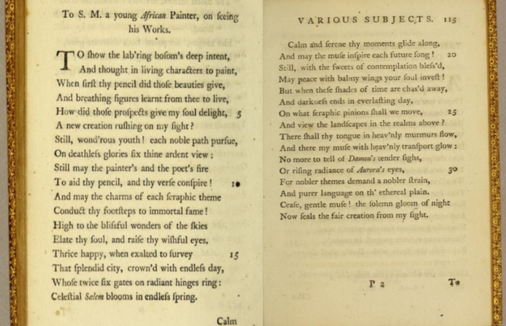|
[Originally published on Facebook 22 April 2021]
Our second poem is called, “To S.M., a Young African Painter, on Seeing His Works”. It belongs to Phillis’ poetry collection entitled, “Poems on Various Subjects, Religious and Moral” that was published in 1773. A link to the digitized version is provided at the end of this post. Here is the poem: To show the lab’ring bosom’s deep intent, And thought in living characters to paint, When first thy pencil did those beauties give, And breathing figures learnt from thee to live, How did those prospects give my soul delight, A new creation rushing on my sight? Still, wond’rous youth! each noble path pursue, On deathless glories fix thine ardent view: Still may the painter’s and the poet’s fire To aid thy pencil, and thy verse conspire! And may the charms of each seraphic theme Conduct thy footsteps to immortal fame! High to the blissful wonders of the skies Elate thy soul, and raise thy wishful eyes. Thrice happy, when exalted to survey That splendid city, crown’d with endless day, Whose twice six gates on radiant hinges ring: Celestial Salem blooms in endless spring. Calm and serene thy moments glide along, And may the muse inspire each future song! Still, with the sweets of contemplation bless’d, May peace with balmy wings your soul invest! But when these shades of time are chas’d away, And darkness ends in everlasting day, On what seraphic pinions shall we move, And view the landscapes in the realms above? There shall thy tongue in heav’nly murmurs flow, And there my muse with heav’nly transport glow: No more to tell of Damon’s tender sighs, Or rising radiance of Aurora’s eyes, For nobler themes demand a nobler strain, And purer language on th’ ethereal plain. Cease, gentle muse! the solemn gloom of night Now seals the fair creation from my sight. This poem shows us that there can be philosophical topics in poetry, topics from Philosophy of Art, or Aesthetics, including: beauty and the problem of expressing the eternal in the human realm, the aesthetical effect provoked by the author and the possibility of such an effect, timelessness or the eternal, including the nature of space in heaven. Wheatley also mentions the relationship between poetry and painting, as if both the poet and the painter conspire. Although we could continue to think broadly about such topics, it is interesting to note one particularity. Both Wheatley and the painter have something in common besides being a creator of life (a “poetes”, ποιητης). They are of the same strain. In this context, we understand “strain” as being of race, generation. By the title, this poem is to a young African painter; by the author, this poem is by an African poet. What would you think that Wheatley had in mind when she wrote this poem about an African painter in 1773? Digitized version [Internet Archive]: https://archive.org/.../poemsonvariouss.../page/114/mode/1up -MM
0 Comments
|
Authors
Jacinta Shrimpton is a PhD student in Philosophy at the University of Sydney. She is co-producer of the ENN New Voices podcast Archives
May 2024
Categories
All
|

 RSS Feed
RSS Feed